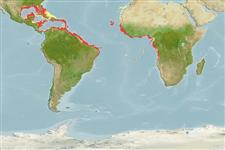Environment: milieu / climate zone / depth range / distribution range
Ecologia
marino associati a barriera corallina; distribuzione batimetrica ? - 650 m (Ref. 3686), usually 50 - 300 m (Ref. 26999). Subtropical; 30°N - 14°S, 98°W - 15°E (Ref. 34024)
Western Atlantic: off the continental coast from Florida, USA and the Gulf of Mexico to northern South America, including islands in the Caribbean. Eastern Atlantic: off Senegal to Angola.
Size / Peso / Age
Maturity: Lm ? range ? - ? cm
Max length : 94.0 cm TL maschio/sesso non determinato; (Ref. 40637); common length : 50.0 cm TL maschio/sesso non determinato; (Ref. 5217); peso massimo pubblicato: 8.5 kg (Ref. 40637)
Short description
Chiavi di identificazione | Morfologia | Morfometria
Spine dorsali (totale) : 0; Raggi dorsali molli (totale) : 109 - 117; Spine anali: 0; Raggi anali molli: 86 - 90. Body completely covered with small, imbricate, cycloid scales; barbels present on snout (6) and chin (6); branchiostegal rays 8; median basibranchial tooth patch absent; developed gill rakers on first arch 4 or fewer; pelvic fin rays inserted at about level of preopercle, well behind eye (Ref. 34024). Ventral fins dark, gradually becoming darker at the extreme blackish edge (Ref. 13608).
Common species (Ref. 34024). Adults benthopelagic (Ref. 34024) down to 650 m, but most often on the continental shelf (Ref. 3686), on sandy and muddy bottoms (Ref. 2683). Juveniles common in reefs (Ref. 34024). Smaller silvery specimens taken far out at sea in the epipelagic (Ref. 34024). Oviparous, with oval pelagic eggs floating in a gelatinous mass (Ref. 205).
Life cycle and mating behavior
Maturità | Riproduzione | Deposizione | Uova | Fecundity | Larve
Nielsen, J.G., D.M. Cohen, D.F. Markle and C.R. Robins, 1999. Ophidiiform fishes of the world (Order Ophidiiformes). An annotated and illustrated catalogue of pearlfishes, cusk-eels, brotulas and other ophidiiform fishes known to date. FAO Fish. Synop. 125(18):178p. Rome: FAO. (Ref. 34024)
IUCN Red List Status (Ref. 130435: Version 2024-2)
Threat to humans
Harmless
Human uses
Pesca: scarso interesse commerciale; Pesce da pesca sportiva: si
Strumenti
Special reports
Download XML
Fonti Internet
Estimates based on models
Preferred temperature (Ref.
123201): 12.5 - 26.5, mean 19.7 °C (based on 331 cells).
Phylogenetic diversity index (Ref.
82804): PD
50 = 0.5156 [Uniqueness, from 0.5 = low to 2.0 = high].
Bayesian length-weight: a=0.00372 (0.00177 - 0.00779), b=3.15 (2.96 - 3.34), in cm total length, based on LWR estimates for this species & (Sub)family-body (Ref.
93245).
Trophic level (Ref.
69278): 3.9 ±0.6 se; based on size and trophs of closest relatives
Generation time: 5.9 ( na - na) years. Estimated as median ln(3)/K based on 1
growth studies.
Resilienza (Ref.
120179): Medio, tempo minimo di raddoppiamento della popolazione 1.4 - 4.4 anni (K=0.19).
Fishing Vulnerability (Ref.
59153): Moderate to high vulnerability (52 of 100).
Climate Vulnerability (Ref.
125649): High vulnerability (65 of 100).
Nutrients (Ref.
124155): Calcium = 16.9 [8.3, 42.6] mg/100g; Iron = 0.451 [0.245, 0.908] mg/100g; Protein = 17.8 [15.3, 20.4] %; Omega3 = 0.183 [0.095, 0.343] g/100g; Selenium = 36.5 [17.0, 76.8] μg/100g; VitaminA = 28.2 [8.7, 94.9] μg/100g; Zinc = 0.568 [0.373, 0.874] mg/100g (wet weight);
